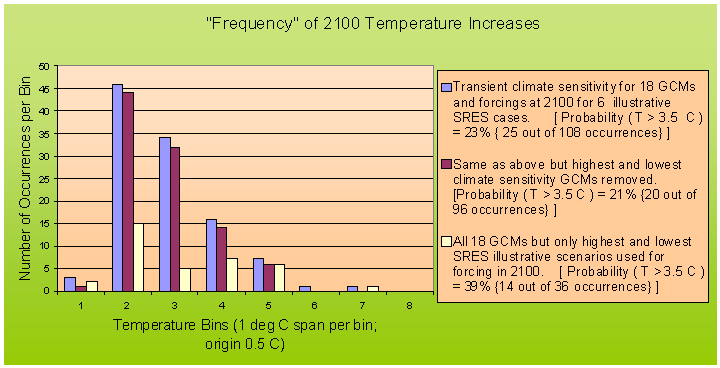
Figure — "Frequency" of temperature increases around 2100 (source: Schneider, 2002a). This figure contains histograms of the number of occurrences of temperature increases around 2100 in seven bins, each 1 C wide and beginning at 0.5 C (e.g., the bin labeled 3 represents the number of occurrences of temperature increases for each case shown between 2.5 and 3.5 C of warming at 2100). The blue bars represent a case of the distribution that results from the product of (a) all 18 GCM transient climate sensitivities (in C warming for a transient climatic forcing at the time of an equivalent doubling of CO2) (from Table 9.1 of IPCC, 2001a), and (b), all 6 forcings at the year 2100 (in W/m2) from the 6 SRES illustrative scenarios (from Figure 19 of the Technical Summary of IPCC, 2001a). [To use the transient climate sensitivities for a wide range of forcings, they are first scaled by the equivalent to a doubling of CO2; i.e., each of the 6 forcings are divided by 4 W/m2 — a typical estimate for forcing when CO2 doubles.] For the 108 numbers represented by the joint inclusion of 18 GCM sensitivities and 6 SRES illustrative scenario forcings, 25 out of the 108 occur in bins representing temperature increases in 2100 greater than a threshold value of 3.5 C — a value many would consider to represent a potential for significant climate damage. The red bars represent a trimmed case in which the highest and lowest climate sensitivities of the 18 GCMs on Table 9.1 of IPCC, 2001a are removed from the analysis. In this case only 21% (20 out of 96) of the occurrences are greater than the threshold warming of 3.5 C. Finally, the white bars represent a case in which all 18 GCM sensitivities are used, but only two SRES forcings (the highest, A1FI, and the lowest, B1) are used. The number of occurrences (14 out of 36) greater than the threshold of 3.5 C warming in 2100 represents a much larger likelihood (39%) of "dangerous" climatic damage than for either of the other two cases. (3.5 oC is a conservative estimate for triggering 'dangerous' impacts, as the European Union, for example, has said it believes that threshold is at 2 oC.)